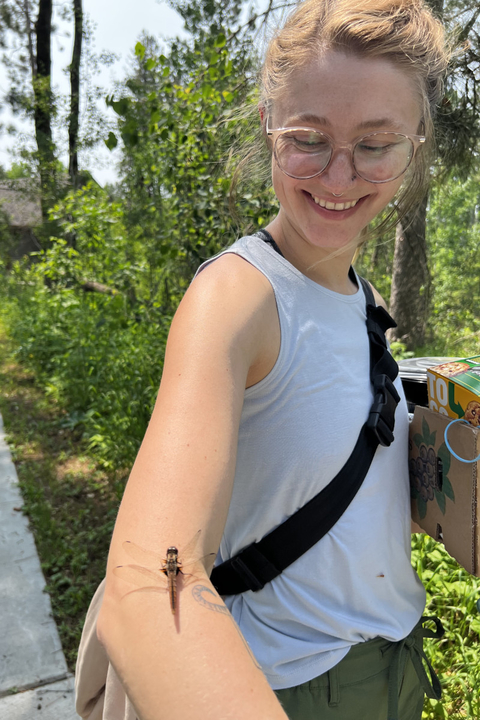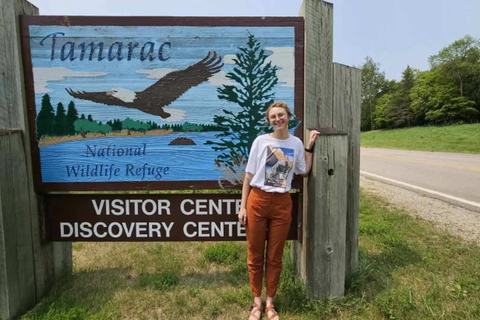Outdoor learning experiences can boost academic learning, personal development and environmental stewardship. The University of Minnesota Extension Youth Development Department is working to identify and address access and equity barriers to help young people experience the outdoors.
At Tamarac National Wildlife Refuge in rural Becker County, the belief is clear: nature is for everyone and leadership is committed to ensuring that the gateway to the outdoors remains wide open.
Kelly Blackledge, head of visitor services and environmental education for the refuge, explains, “Tamarac Refuge runs an environmental education program in collaboration with the Friends of Tamarac, a nonprofit volunteer organization, and about 10 local school districts.”
“It's not just a one-time field trip,” Blackledge emphasizes. They aim to make students feel like the refuge is an outdoor school and learning space.
Each season, the refuge welcomes around 900 students. But after feedback from teachers, the refuge learned that some students with physical or cognitive disabilities were opting out of visiting the refuge with their classmates. To assist in their efforts to enhance accessibility, the Friends of Tamarac National Wildlife Refuge was awarded support from University of Minnesota Extension Regional Sustainable Development Partnerships (RSDP) in 2022.
“We received our RSDP grant and were able to start looking at how we can improve our programs,” explains Blackledge. The refuge completed a series of upgrades focused on the physical environment, including an accessibility update to the trail system. But Blackledge notes that physical upgrades are only half the story.
“That’s where Myra came in.”
A fresh perspective
Myra McKee says she’s grateful for her childhood spent outdoors.
“I basically grew up outside at the nature center where my mom worked, just outside Lincoln.” she recalls. While McKee cherishes her childhood memories in Nebraska’s nature, she understands that not everyone has such fond experiences.
“The outdoors can be intimidating for people with different experiences,” she says. “It’s important we help connect others with nature and assist them in feeling like they are able to take it on.”
McKee went on to graduate from the University-Nebraska Lincoln. Today she is working toward her master's degree in public health and environmental health at the University of Minnesota School of Public Health. Following her educational interests and personal passion, McKee recently worked with the Tamarac National Wildlife Refuge to help more people connect with nature. In partnership with RSDP, McKee spent three months as an accessibility intern with the refuge.
“I was fortunate enough to work with the refuge to learn about their programming and goals. We discussed accessibility in its diverse forms and brainstormed welcoming adaptations,” recalls McKee.
Blackledge recalls, “We needed tools that would ease the newness and the anxiety of visiting a new place and seeing new people and being in this environment. A volunteer came to us with the idea of creating ‘social stories’ but we didn’t know much about them.”
A picture is worth a thousand words
Social stories are a modern accessibility tool. The stories come in the form of a physical booklet that contains images and accessible language to prepare people of all abilities for new situations. They help explain what readers can expect in the situation, how to react, and answer questions about when, why, and who is involved.
“In our case, we wanted the materials to take the reader through the visuals of an education day at the refuge,” says Blackledge. During her term, McKee collaborated with Tamarac to create and customize these accessibility materials for the refuge's unique setting.
“She made the trek from the Twin Cities for a site visit and she was able to see kids here learning outdoors. The beauty of it was she hadn’t been here before, so she brought a sort of first-time perspective to the stories, which would be valuable to the reader.”
The project resulted in twelve social stories, one story for each season for visitors in various grades. Each social story was created using accessible formatting with the goal of sharing the stories ahead of visits to the refuge for students who would benefit from prior acclimation.
“They describe how that day might feel, or smell, or sound, as well as what it would look like out there,” says Blackledge. “For example, explaining that one might be in an area that's really sunny and it could get warm, or the sound of the trail walking on crushed granite. It really has a neat feel!”
The social stories were distributed to partner schools, quickly eliciting enthusiastic feedback, especially from teachers.
Blackledge says, “In fact, they shared the social stories with the whole class. One teacher said she was super grateful that all her students had a better understanding of what to expect for the day and what was expected of them. Learning that these stories actually served a broader range of students was a cool surprise!”
Blackledge says the experience working with McKee and RSDP was crucial.
“RSDP has been really a critical resource for us, in a way we haven’t found with other organizations,” says Blackledge. “They’ve provided expertise in the arenas that we’ve been trying to explore by putting us in contact with university personnel and students like Myra. We’ve never before experienced this level of support and facilitation!”
The experience was equally rewarding for McKee. She says it has impacted her career trajectory.
“I would love to work somewhere that’s making accessibility a primary part of their mission,” she says. “I’m proud to be part of a growing movement to make outdoor spaces for everyone.”




